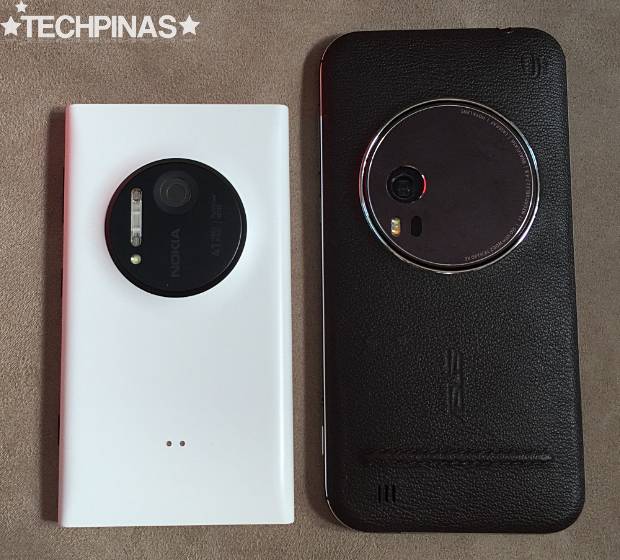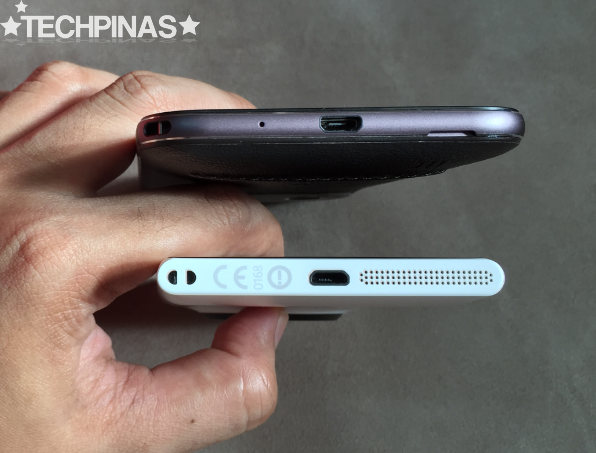Asus ZenFone Zoom vs. Nokia Lumia 1020 Design Comparison, Side by Side Photos
"Sir Mark, does Asus ZenFone Zoom really look like Nokia Lumia 1020 in the flesh?"
"The ZenFone Zoom's design appears to be inspired by the Lumia 1020. How exactly are they different in terms of build or construction?"
"Is Asus ZenFone Zoom a lot bigger than the Lumia 1020?"

These are only some questions that I got from my readers when I first posted photos of my Asus ZenFone Zoom on my social media accounts earlier this month.
As many of you know, I've been a Nokia Lumia 1020 owner since the legendary cameraphone was launched in the Philippines last October 2013. And I still use the Windows Phone device up to this day to take photos and record videos during events.
Luckily, I also got hold of the Asus ZenFone Zoom as soon as it hit the market just a few days ago, putting me in a great position to do a series of comparison posts for you guys. I reckon such entries are necessary considering the many similarities between these two models, most notable of which is stellar imaging capability -- highlighted by the circular camera module on the back of either handsets.
For those who are thinking about purchasing Asus new powerhouse imaging-centric smartphone, I hope this entry - as well as future ones - can help you make a decision.
That said, allow me to start by showing you side by side photos of the two handsets and giving a short commentary on each shot.








I intend to dedicate a whole separate entry just to talk about the imaging capabilities of these two smartphones in detail and to show you full-res 'shoot-out' images. For now, let me just touch on the camera specs just a bit.



Conclusion: Nokia Lumia 1020 and Asus ZenFone Zoom have their individual strengths when it comes to design and build. Nokia Lumia 1020 is slimmer, smaller and lighter, making it easier to have in the pocket or hold when capturing images. In that sense, one can say that the 1020's ergonomics make it a tad more convenient to use as a cameraphone. On the other hand, Asus ZenFone Zoom features a far more opulent or luxurious construction -- thanks to its real metal frame and genuine leather back finish. I know beauty is in the eyes of the beholder -- and if you ask me, I'd tell you that Asus ZenFone Zoom is not only beautiful but also very elegant. I also want to note that the ZenFone Zoom's large footprint merely reflects its powerhouse technical specifications and features (apart from its imaging capabilities), making it a beast of an Android phone that can easily give many 2015 and 2016 flagship handsets by other brands a serious run for the money.
Next: Camera Shoot-out! Stay tuned!
"The ZenFone Zoom's design appears to be inspired by the Lumia 1020. How exactly are they different in terms of build or construction?"
"Is Asus ZenFone Zoom a lot bigger than the Lumia 1020?"

These are only some questions that I got from my readers when I first posted photos of my Asus ZenFone Zoom on my social media accounts earlier this month.
As many of you know, I've been a Nokia Lumia 1020 owner since the legendary cameraphone was launched in the Philippines last October 2013. And I still use the Windows Phone device up to this day to take photos and record videos during events.
Luckily, I also got hold of the Asus ZenFone Zoom as soon as it hit the market just a few days ago, putting me in a great position to do a series of comparison posts for you guys. I reckon such entries are necessary considering the many similarities between these two models, most notable of which is stellar imaging capability -- highlighted by the circular camera module on the back of either handsets.
For those who are thinking about purchasing Asus new powerhouse imaging-centric smartphone, I hope this entry - as well as future ones - can help you make a decision.
That said, allow me to start by showing you side by side photos of the two handsets and giving a short commentary on each shot.

Nokia Lumia 1020 (Left) sports a 4.5-inch HD AMOLED display while Asus ZenFone Zoom has a 5.5-inch IPS+ screen, making it a full-fledged phablet. That's a full inch difference in viewing space.

Lumia 1020's flaunts a durable unibody-polycarbonate shell with 'pillow' like form. ZenFone Zoom, on the other hand, comes with a CNC-crafted anodized aluminum mid-frame and a polycarbonate removable back plate lined with real Italian leather.

These are the top panels on either phones; Both donning the 3.5mm audio jack as well as a microphone pin-hole. Lumia 1020 has its SIM tray here, though.

Both handsets have their microUSB port and landyard loop located at the rear. The loud speaker of Nokia Lumia 1020 can also be found here while that of ZenFone Zoom is located at the back near the bottom.

Notice the similar location of the power button, volume rocker, and camera button on the right panel of both phones. ZenFone Zoom has an extra button, though, for video capture (the smaller one beside the one for the still shooter); Long pressing it - from screen off - instantly launches the video recorder, which is really handy.

ZenFone Zoom is 12 millimeters thick. Lumia 1020, on the other hand, measures 10.4 millimeters.

Asus' cameraphone is 158.9 millimeters long and 78.8 millimeters wide while Nokia's 41-MegaPixel snapper measures 130.4 by 71.4 millimeters. Talk about a major difference in footprint. As for weight, Lumia 1020 is 158 grams while ZenFone Zoom is 185 grams.

On the two handsets, the circular plate protecting the camera module is made of real metal. The one on Nokia Lumia 1020 has a diameter of 3.5 centimeters while Asus ZenFone Zoom's measures 4.25 centimeters across. Lumia's camera plate protrudes a bit more.
I intend to dedicate a whole separate entry just to talk about the imaging capabilities of these two smartphones in detail and to show you full-res 'shoot-out' images. For now, let me just touch on the camera specs just a bit.

Nokia Lumia 1020: 41 MegaPixels (38 MegaPixels effective, 7152 x 5368 pixels), Carl Zeiss optics, Optical Image Stabilization, AutoFocus, Xenon flash, LED flash, 1/1.5" sensor size, 1.12 µm pixel size, Nokia PureView Technology (oversampling), Geo-tagging, Face Detection, Dual Capture, Panorama, Manual Mode for DSLR-like camera detail settings

Asus ZenFone Zoom: 13 MegaPixels (4208 x 3120 pixels), 10 -element HOYA lens, Optical Image Stabilization, 0.03 second laser AutoFocus, Dual Tone LED flash, Back Light (HDR) mode with ASUS PixelEnhancing Technology for up to 400% brighter and videos, Geo-tagging, Face Detection, Dual Capture, Panorama, Manual Mode for DSLR-like camera detail settings, Real Time Beautification

Though both phones have camera modules that jut out of their back panels, Asus ZenFone Zoom can sit flat on a table - instead of reclined like the Lumia 1020 - as it has a ridge near the bottom to balance out the protrusion on the upper part.
Conclusion: Nokia Lumia 1020 and Asus ZenFone Zoom have their individual strengths when it comes to design and build. Nokia Lumia 1020 is slimmer, smaller and lighter, making it easier to have in the pocket or hold when capturing images. In that sense, one can say that the 1020's ergonomics make it a tad more convenient to use as a cameraphone. On the other hand, Asus ZenFone Zoom features a far more opulent or luxurious construction -- thanks to its real metal frame and genuine leather back finish. I know beauty is in the eyes of the beholder -- and if you ask me, I'd tell you that Asus ZenFone Zoom is not only beautiful but also very elegant. I also want to note that the ZenFone Zoom's large footprint merely reflects its powerhouse technical specifications and features (apart from its imaging capabilities), making it a beast of an Android phone that can easily give many 2015 and 2016 flagship handsets by other brands a serious run for the money.
Next: Camera Shoot-out! Stay tuned!
| Name | Asus Zenfone Zoom Philippines ZX551ML |
| Type | Slate Form Factor (Full Touchscreen), Digital Camera Phablet Hybrid |
| Price Category | High-end (Flagship Level) |
| Dimensions | 158.9 x 78.8 x 12 mm |
| Weight | 185 grams |
| Available Colors | Black (Italian Leather) |
| Operating System (upon launch) | Android 5.0 Lollipop with Zen UI |
| Display | 5.5 inches (~403 ppi pixel density), 1080 x 1920 pixels, IPS+, capacitive touchscreen, 16M colors, Gorilla Glass 4 |
| Processor | Quad Core 64-bit 2.5 GHz Intel Atom Z3590 chipset with PowerVR G6430 GPU |
| RAM | 4 GB of RAM |
| Internal Storage | 128 GB of ROM, expandable via microSD card slot |
| Camera | Main: 13 MegaPixels, 4208 x 3120 pixels, autofocus, Dual Tone LED flash Front: 5 MegaPixels |
| Video Capture | Full HD 1080p 30 frames per second for main camera, HD for front camera (TBC) |
| Audio and Video Playback | MP3, WAV, eAAC+, FLAC, MP4, H.264 |
| Ports | microUSB v2.0, 3.5 mm audio jack |
| Connectivity | Wi-Fi 802.11 a/b/g/n, Wi-Fi Direct, DLNA, Wi-Fi hotspot, Bluetooth v4.0 with A2DP, EDR, 3G HSDPA, 21 Mbps; HSUPA, 5.76 Mbps, HSPA+; LTE Cat4, NFC |
| GPS | Yes, with GLONASS and A-GPS |
| FM Radio | Yes |
| Sensors | Accelerometer, Digital Compass, Proximity Gyroscope |
| Network | 2G GSM 850 / 900 / 1800 / 1900 - SIM 1 and SIM 2, 3G HSDPA 850 / 900 / 1900 / 2100, 4G LTE 700 / 800 / 850 / 900 / 1700 / 1800 / 1900 / 2100 / 2600 (Bands 1, 2, 3, 4, 5, 7, 8, 9, 17, 18, 19, 20, 28, 29), TD-LTE 1900 / 2300 / 2500 / 2600 (Bands 38, 39, 40, 41) |
| SIM Card Type | Single microSIM |
| Battery | Non-removable 3,000 mAh Li-Po battery |
| Uptime | TBD |
| Value-Added Features | Zen UI, PixelMaster camera, Affordable price tag; Top-notch specs, Fast Charging |
| Announcement | Philippines, January 16, 2016 ~ ZenFestival 2016, Cebu City |
| Availability | January 2016 |
| Price | Official SRP upon Launch: Php 26,995 |
| Name | Nokia Lumia 1020 Philippines |
| Type | Slate Form Factor (Full Touchscreen), Digital Camera Smartphone Hybrid |
| Price Category | High-End (Flagship Level) |
| Dimensions | 130.4 x 71.4 x 10.4 mm, 96.9 cc |
| Weight | 158 grams |
| Available Colors | Yellow, White, Black |
| Operating System (upon launch) | Windows Phone 8 |
| Display | 4.5-inch 768 x 1280 pixels (~332 ppi) PureMotion HD+, AMOLED, ClearBlack, Super Sensitive Touch for Nail and Glove use, Nokia ClearBlack with high brightness mode and Sunlight Readability Enhancements, Corning Gorilla Glass 3 |
| Processor | Dual Core 1.5 GHz Krait CPU, Adreno 225, Qualcomm MSM8960 Snapdragon chipset |
| RAM/ROM | 2 GB RAM |
| Camera | 41 MegaPixels (38 MegaPixels effective, 7152 x 5368 pixels), Carl Zeiss optics, optical image stabilization, autofocus, Xenon & LED flash Special features: 1/1.5" sensor size, 1.12 µm pixel size, PureView technology, geo-tagging, face detection, dual capture, panorama |
| Video Capture | Full HD 1080p 30 frames per second, Front: 720p |
| Audio and Video Playback | MP3, WMA, WAV, eAAC+, MP4, DivX, XviD, H.264, H.263, WMV player |
| Ports | microUSB v2.0, 3.5 mm audio jack |
| Connectivity | NFC, Wi-Fi 802.11 a/b/g/n, Wi-Fi hotspot, Bluetooth 3.1, A-GPS/GLONASS, 4G LTE, LTE Cat3 100Mbps/50Mbps, HSDPA+ Dual Carrier cat24 (42 Mbps), HSUPA cat 6: 5.8 Mbps |
| Network | GSM 850/900/1800/1900, WCDMA 850/900/1900/2100, LTE 800/900/1800/2100/2600 |
| Internal Storage | 32 GB mass memory with 7GB free SkyDrive storage, fixed |
| Sensors | Accelerometer, Digital Compass, Gyro, Proximity |
| Battery | 2000 mAh Li-Ion with integrated Qi wireless charging, non-removable |
| Uptime | Talk time: (GSM/WCDMA) 2G – up to 19 hours, 3G – up to 13 hours 20 minutes, Standby time: (GSM/WCDMA) up to 384 hours, Music playback: up to 63 hours |
| Value-Added Features | First WP handset with 41 MegaPixel camera, PureView imaging technology, Nokia Smart Camera, Nokia Pro Camera |
| Announcement | Philippines: October 1, 2013 |
| Availability | Official Release Date: October 11, 2013 |
| Price | Official SRP upon Launch: Php 35,650 - comes with free Camera Grip worth Php 4,000 |
Labels:
Asus
Asus ZenFone Zoom
Asus ZenFone Zoom Philippines
Asus ZenFone Zoom vs. Nokia Lumia 1020
Cameraphone
Cellphone
Nokia
Nokia Lumia 1020
Smartphones
Versus




.jpg)